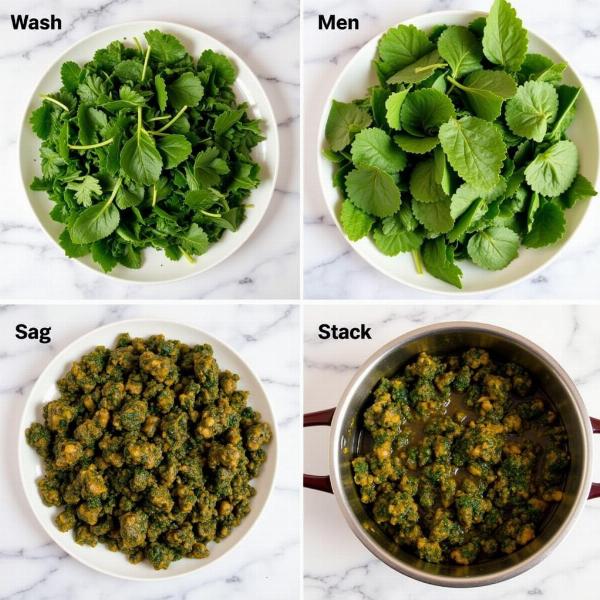Saag, a staple in Indian cuisine, often translates to “greens” in English. However, understanding the true meaning of saag in Hindi goes beyond a simple translation. It encompasses a rich culinary tradition, diverse regional variations, and deep cultural significance. This article will explore the various aspects of saag meaning in Hindi, from its linguistic roots to its place on the Indian dining table.
Understanding the Nuances of “Saag”
While “greens” is a common translation, saag can refer to a wide variety of leafy vegetables, including spinach, mustard greens, fenugreek leaves, and more. The specific type of saag used varies by region and season, leading to a delightful array of flavors and textures. Moreover, saag isn’t just about the raw ingredient; it also refers to the dish itself, often a creamy, flavorful curry made with these leafy greens.
 Saag Preparation
Saag Preparation
Regional Variations of Saag Dishes
India’s diverse culinary landscape offers a fascinating array of saag preparations. Sarson ka saag, made from mustard greens and popular in Punjab, is perhaps the most well-known. However, other regions boast their own unique versions, like palak saag (spinach) in many parts of North India or gongura (sorrel leaves) in Andhra Pradesh. Each variety carries its own distinct flavor profile, showcasing the ingenuity and creativity of Indian cuisine.
Saag: More Than Just Food
Saag isn’t merely a culinary ingredient; it holds cultural significance, often associated with health, nourishment, and tradition. In many Indian households, saag is a regular part of the diet, passed down through generations. Its simple preparation and wholesome nature make it a comforting and familiar dish, deeply ingrained in the fabric of Indian life.
Saag in Everyday Language
Saag also finds its way into everyday Hindi conversations. It can be used metaphorically to describe anything green or leafy, or even to describe someone who is inexperienced or naive (“hara bhara,” meaning green and fresh). This reflects the deep integration of saag into the linguistic and cultural consciousness of Hindi speakers.
What are the most common types of Saag?
Several types of saag are popular in Indian cuisine, including sarson ka saag, palak saag, methi saag (fenugreek leaves), and bathua saag (lamb’s quarters). Each type offers a unique flavor and texture.
Conclusion: The Rich Tapestry of Saag
From its linguistic roots to its cultural significance, saag meaning in Hindi encompasses a rich tapestry of flavors, traditions, and regional variations. More than just “greens,” saag represents a vital part of Indian culinary heritage.
FAQ:
- What does saag literally mean in Hindi? Saag literally translates to “greens” or “leafy vegetables.”
- What is the most popular saag dish? Sarson ka saag is arguably the most popular saag dish, especially in Punjab.
- Is saag healthy? Yes, saag is generally considered very healthy, rich in vitamins and minerals.
- Can saag be eaten raw? While some saag can be eaten raw in salads, it’s most commonly cooked.
- What is saag paneer? Saag paneer is a popular dish made with saag and Indian cheese (paneer).
- What is saag aloo? Saag aloo is a dish made with saag and potatoes.
- Where can I find saag recipes? Numerous saag recipes are readily available online and in cookbooks.
Meaning-Hindi.in is your one-stop solution for all your Hindi translation needs. We offer a wide range of professional translation services, from business and legal documents to technical manuals and website localization. Our expert team ensures accurate and culturally sensitive translations, catering to diverse linguistic and cultural backgrounds. Contact us today for a free quote! Email: [email protected], Phone: +91 11-4502-7584. Let Meaning-Hindi.in bridge the language gap for you.